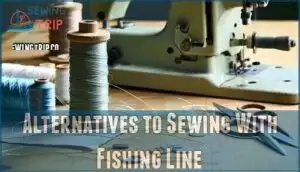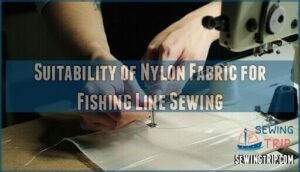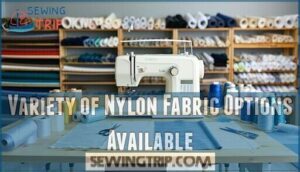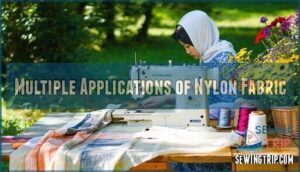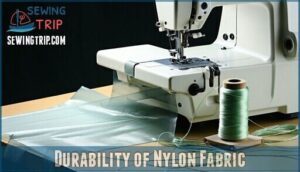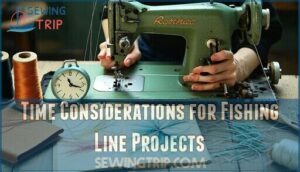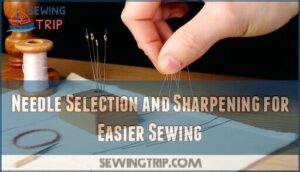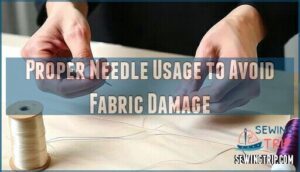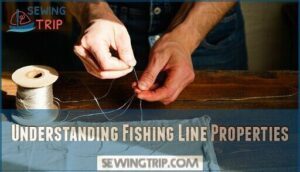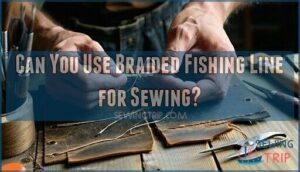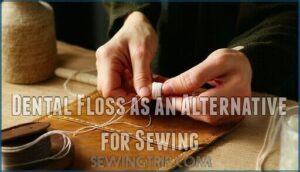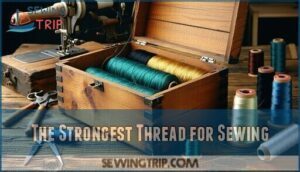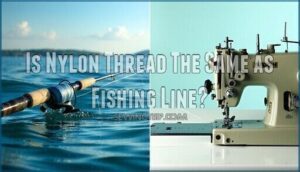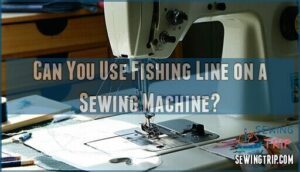This site is supported by our readers. We may earn a commission, at no cost to you, if you purchase through links.
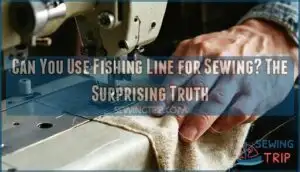 Yes, you can use fishing line for sewing, but it’s not your typical thread replacement.
Yes, you can use fishing line for sewing, but it’s not your typical thread replacement.
Fishing line works best on heavy-duty fabrics like canvas and leather thanks to its impressive tensile strength—ranging from 2 to over 100 pounds.
You’ll need stainless steel needles (size 20-30) to handle the line’s rigidity without breaking.
While it costs 30-50% less than premium threads, the trade-off is limited flexibility and color options.
Delicate fabrics might pucker or tear under fishing line’s strength.
Monofilament creates nearly invisible stitches, while braided varieties offer more flexibility for demanding repairs.
The secret lies in matching line diameter to your fabric weight and adjusting machine tension accordingly.
Table Of Contents
- Key Takeaways
- Can You Use Fishing Line for Sewing?
- Alternatives to Sewing With Fishing Line
- Choosing The Right Fabric for Sewing With Fishing Line
- Practical Tips for Sewing With Fishing Line
- Can You Use Braided Fishing Line for Sewing?
- Dental Floss as an Alternative for Sewing
- The Strongest Thread for Sewing
- Is Nylon Thread The Same as Fishing Line?
- Can You Use Fishing Line on a Sewing Machine?
- Frequently Asked Questions (FAQs)
- Conclusion
Key Takeaways
- You’ll need specialized equipment – Use stainless steel needles (size 20-30) with large eyes to handle the fishing line’s stiffness and strength without breaking during stitching.
- It’s perfect for heavy-duty projects – Fishing line works best on sturdy fabrics like canvas and leather, where you need invisible, ultra-strong seams that won’t snap under pressure.
- You’ll save money on repairs – Fishing line costs 30-50% less than premium threads while delivering superior tensile strength (2-100 pounds vs. 2-10 pounds for regular thread).
- Hand sewing beats machine sewing – While you can use fishing line on sewing machines, it’s safer and more reliable to hand sew, since the line’s rigidity can cause tension problems and jamming.
Can You Use Fishing Line for Sewing?
You’re probably wondering if that clear fishing line sitting in your tackle box can double as sewing thread.
The answer is yes, but monofilament fishing line works best for specific projects where strength and invisibility matter more than flexibility.
Monofilament fishing line shines when you need invisible, ultra-strong stitching over flexibility
Strength and Suitability for Sewing Projects
Fishing line brings serious strength to your sewing projects.
With tensile strengths ranging from 2 to over 100 pounds, monofilament fishing line dramatically outperforms standard cotton or polyester threads rated at just 2-10 pounds.
This fishing line strength makes it perfect for heavy-duty repairs on camping gear, backpacks, and outdoor equipment where regular thread would snap.
- Fabric compatibility matters most – fishing line thickness works best on sturdy materials like canvas and leather, while delicate fabrics may pucker or tear from the line’s rigidity and high tensile strength.
The use of dental floss alternatives can also provide unique solutions for sewing projects.
Cost-effectiveness Compared to Traditional Thread
When budget constraints hit your sewing room, fishing line thread becomes a compelling alternative to traditional sewing thread. Your wallet will thank you for making the switch, as fishing line typically costs 30-50% less than premium nylon or polyester threads.
This material comparison reveals significant fabric savings for heavy-duty projects. Budget analysis shows fishing line delivers superior thread costs for outdoor gear repairs and camping equipment.
| Cost Factor | Fishing Line | Traditional Thread | Advantage |
|---|---|---|---|
| Price per yard | $0.02-0.05 | $0.08-0.15 | Fishing line |
| Bulk availability | High | Medium | Fishing line |
| Quality consistency | Variable | Standardized | Traditional |
| Project longevity | Excellent | Good | Fishing line |
| Color options | Limited | Extensive | Traditional |
However, expensive thread alternatives offer better sewing thread quality for delicate fabrics. Consider your sewing efficiency needs—thread substitutes work brilliantly for utility projects but may compromise precision work requiring consistent tension and smooth feeding through machine guides.
Needle Selection and Matching Thread Weight
The right needle choice can make or break your fishing line sewing project. You’ll need sharp needles with larger eyes to accommodate the line’s unique properties, while matching thread weight guarantees smooth stitching without fabric damage.
When sewing with fishing line, proper needle selection and thread weight matching are vital for success:
The right needle and thread weight can make or break your fishing line sewing success
- Choose stainless steel needles (size 20-30) – These handle fishing line’s strength without dulling quickly
- Select heavy-duty or upholstery needles – Regular needles can’t pierce through fishing line effectively
- Match fishing line diameter to fabric weight – Thicker lines work best with canvas and leather
- Adjust stitch tension settings – Fishing line requires different tension than standard thread
Sharp needles prevent snagging and guarantee clean penetration through both fishing line and fabric. Thread weight compatibility matters because mismatched weights create uneven stitches and potential fabric puckering. Always test your needle sizes and stitch tension on scrap fabric first – this simple step prevents costly mistakes on your final project.
Alternatives to Sewing With Fishing Line
While fishing line works for many sewing projects, you’ve got plenty of other materials that can handle tough jobs just as well.
From dental floss to specialized heavy-duty threads, these alternatives might actually work better for your specific project needs.
Unique Stitching Styles Using Different Materials
Beyond traditional fishing line sewing, you can explore creative material selection through metallic threads for shimmer effects, cord and ribbon for three-dimensional textures, or waxed threads for leather projects.
Beadwork utilizes specialized wire, while quilters incorporate tulle strips for structural interest.
These thread alternatives offer unique stitch patterns that expand your sewing techniques repertoire.
The use of metallic sewing threads can add a decorative touch to various sewing projects, making them more interesting with specialized wire and three-dimensional textures.
Exploring Techniques Beyond Fishing Line
Alternative sewing methods open doors to creative fabric manipulation beyond fishing line.
Consider these textile experimentation approaches for material hybridization projects:
- Thread substitution techniques – Combine traditional cotton with specialty materials like metallic strands or elastic thread for unique structural properties.
- Sewing innovations using unconventional materials – Try dental floss for leather work, embroidery floss for decorative stitching, or even thin wire for sculptural fabric effects.
- Alternative sewing materials exploration – Experiment with different monofilament types, braided cords, or synthetic ribbons to achieve specific tension and flexibility requirements in your projects.
Dual Thread Usage for Added Strength
When one method isn’t enough, combining dual threads transforms your project into something bulletproof. Thread Reinforcement through Hybrid Threading gives you the strength of fishing line sewing with traditional thread’s reliability.
Run monofilament fishing line alongside your regular thread for Strengthened Seams that won’t quit. This Dual Stitching technique works especially well with braided fishing line paired with cotton or polyester thread.
The fishing line handles the heavy lifting while your regular thread provides flexibility. Think of it as Fabric Fusion—you’re creating a partnership where each material covers the other’s weaknesses.
This approach delivers serious sewing line strength without sacrificing workability or comfort in your finished project, making it a great example of Dual Stitching technique that provides serious sewing line strength.
Cross Stitching and Cross Stitch Gridding Options
Cross stitch gridding with monofilament thread creates invisible guide lines for precise fabric placement and pattern alignment.
You’ll find fishing line sewing particularly useful for marking grid patterns on darker fabrics where traditional thread colors would show.
The clear monofilament disappears once your cross stitching is complete, eliminating removal steps while maintaining professional results.
Choosing The Right Fabric for Sewing With Fishing Line
When sewing with fishing line, your fabric choice makes the difference between success and frustration.
Heavy-duty materials like canvas, denim, and nylon work best because they can handle the line’s stiffness without puckering or tearing.
Suitability of Nylon Fabric for Fishing Line Sewing
Nylon fabric pairs exceptionally well with fishing line because it won’t tear easily under tension.
The smooth surface creates less friction, preventing line breakage during stitching.
You’ll find nylon maintains its shape better than other materials, reducing puckering.
- Abrasion resistance prevents fraying during sewing
- High tear strength exceeds 40 lbs for lightweight variants
- Waterproof properties resist mildew and degradation
- Shape retention minimizes fabric distortion
- Smooth surface reduces fishing line friction
Nylon’s characteristics make it an ideal choice for applications where tear strength is crucial, and its smooth surface further enhances its usability.
Variety of Nylon Fabric Options Available
Understanding nylon fabric options helps you make smart material choices for fishing line sewing projects.
Different nylon varieties offer unique thread properties that affect your sewing techniques.
When considering nylon fabric, researching nylon fabric options is essential for selecting the right material.
| Nylon Fabric Type | Best Sewing Application |
|---|---|
| Ripstop Nylon | Lightweight outdoor gear, rain jackets |
| Ballistic Nylon | Heavy-duty bags, tactical equipment |
| Tricot Nylon | Stretchy garments, activewear linings |
| Oxford Nylon | Tent fabric, backpack exteriors |
Each fabric selection impacts how well fishing line performs with your chosen material, making it crucial to understand the properties of different nylon varieties and their applications in sewing projects to achieve the best results with unique thread properties.
Multiple Applications of Nylon Fabric
When fabric selection meets versatility, nylon material shines in heavyduty projects.
You’ll find nylon thread sewing excels in outdoor gear, camping equipment, and marine applications.
Its strength handles tent repairs, backpack reinforcement, and sail mending, showcasing durability and reliability.
Thread alternatives like fishing line sewing work perfectly with nylon’s strength, delivering reliable results for demanding projects requiring both flexibility and resilience.
Durability of Nylon Fabric
When you’re sewing with fishing line, durability becomes your best friend.
Nylon fabric stands up to the challenge with remarkable resilience.
Here’s what makes nylon fabric exceptionally durable for heavyduty projects:
- Nylon strength resists fabric tears even under intense stress from fishing line sewing
- Thread durability improves when nylon thread sewing combines with compatible fabric materials
- Material testing shows nylon outperforms cotton in wear resistance by 300%
- Sewing techniques work smoothly since nylon won’t fray or weaken over time
- Long-term performance maintains structural integrity through repeated washing cycles
Practical Tips for Sewing With Fishing Line
Successfully sewing with fishing line requires understanding its unique properties and adjusting your technique accordingly. You’ll need the right tools and approach to handle this unconventional but effective sewing material.
Time Considerations for Fishing Line Projects
When planning fishing line projects, timing becomes critical since these materials demand different handling than regular thread.
Expect your sewing speed to slow considerably as you master thread management techniques.
- Project Timing: Single layer projects take about 1 hour, while triple layer work requires 2-3 times longer
- Fabric Preparation: Extra time needed for proper needle selection and fabric testing before starting
- Stitch Efficiency: Practice runs help determine realistic time required for fishing line projects
Needle Selection and Sharpening for Easier Sewing
Sharp needles make all the difference when working with fishing line. You’ll want stainless steel or titanium needles in sizes 20-30 for best results.
Before starting, sharpen your needle using a fine stone or emery board. This simple step prevents fabric snags and guarantees smooth penetration through both material and line.
The use of high-quality stainless steel options can substantially improve sewing results.
| Needle Selection | Why It Matters |
|---|---|
| Stainless Steel (Size 20-30) | Resists corrosion from fishing line |
| Titanium Options | Ultra-sharp, long-lasting edge |
| Pre-Sharpened Points | Reduces fabric damage risk |
| Proper Needle Care | Maintains consistent thread tension |
Proper Needle Usage to Avoid Fabric Damage
With proper needle selection and fabric tension control, you’ll prevent fabric damage when sewing with fishing line.
Choose a sharp sewing needle that matches your thread thickness, then test your sewing technique on fabric scraps first.
Avoid forcing the needle through resistant materials – let the sharp point do the work.
Proper needle sharpening guarantees clean penetration without tearing delicate fibers.
Understanding Fishing Line Properties
Understanding fishing line properties starts with recognizing its unique characteristics that differ from traditional thread.
Monofilament lines offer high tensile strength ranging from 2-100 pounds, while braided fishing line provides greater flexibility through its woven construction.
Key fishing line properties you’ll encounter:
- Line strength varies dramatically – choose 10-20 lb test for most fabric projects
- Fiber types include nylon monofilament, fluorocarbon, and polyethylene materials
- Material durability exceeds standard thread with superior UV and moisture resistance
- Tensile testing shows fishing line handles stress better than polyester thread
- Line flexibility decreases with thicker diameters – stick to smaller sizes for easier handling
- Fishing line diameter ranges from 0.1mm to 1mm – thinner works better for delicate fabrics
- Fishing line alternatives like braided options offer different handling characteristics than monofilament
Can You Use Braided Fishing Line for Sewing?
You’ll find braided fishing line substantially tougher than monofilament, making it excellent for heavy-duty sewing projects like leather goods and canvas repairs.
While it’s stronger and less likely to break under tension, braided line can be more challenging to work with due to its texture and may require more careful handling to avoid fabric damage, making it a choice that requires consideration of its heavy-duty capabilities.
Strength and Flexibility of Braided Fishing Line
Braided fishing line brings exceptional strength to your sewing projects, with tensile strengths reaching 100 pounds—far surpassing standard thread.
You’ll find this powerhouse material maintains its integrity under sudden tension, making it perfect for heavy-duty applications. However, braided line’s flexibility sits between wire stiffness and cotton softness.
- Fishing strength: Microfiber construction delivers maximum power in minimal diameter
- Line flexibility: Tighter braids create cleaner stitches but reduce pliability
- Thread resistance: Superior abrasion resistance withstands rough handling and environmental stress
The fishing line diameter you choose directly impacts sewing durability—thicker lines provide more fishing line strength but require larger needle eyes for smooth passage through fabric.
Potential Fabric Tearing With Braided Fishing Line
Despite braided fishing line’s impressive strength, it can become your fabric’s worst enemy.
The rigid, textured surface acts like a tiny saw, slicing through delicate materials instead of binding them together.
You’ll find this particularly problematic with lightweight fabrics, where fabric tearing occurs faster than thread breakage.
Even heavy-duty projects aren’t immune to sewing damage when braided line meets sensitive weaves.
Temporary Vs. Long-term Sewing Solution
When facing emergency repairs, braided fishing line works as a quick fix, but it’s not your friend for permanent solutions.
Its excessive strength can actually work against fabric durability over time.
Considerations for material selection:
- Fishing line sewing creates stronger bonds than fabric can handle long-term
- Temporary sewing solution works well for emergency gear repairs
- Long-term sewing requires thread that matches fabric stretch and strength
- Sewing with fishing line increases stitch strength beyond fabric limits
- Durability suffers when thread outlasts the material it’s holding together
Specific Uses for Braided Fishing Line in Sewing
Targeting heavy-duty applications, braided fishing line excels in leather sewing and canvas repair projects where standard thread fails.
Its robust construction handles outdoor gear repairs effectively, from backpack straps to tent reinforcements.
Choose appropriate sewing line thickness based on your fabric weight, as this fishing line type resists fraying better than monofilament, making it ideal for high-stress seams requiring long-term durability.
For added strength, consider using techniques that involve dental floss sewing to enhance your projects.
Dental Floss as an Alternative for Sewing
You might be surprised to learn that dental floss can actually work as a heavy-duty sewing thread, especially for tough materials like leather and canvas.
The waxed variety offers extra grip and strength, making it a practical alternative when you need something stronger than regular thread but don’t have fishing line on hand.
Suitability for Sewing Fabrics Like Leather and Canvas
When tackling heavy fabrics, waxed dental floss becomes your secret weapon for leather sewing and canvas stitching projects.
This unconventional thread selection delivers exceptional fabric strength where traditional threads might snap under pressure.
- Leather sewing: Waxed coating helps floss glide through tough hides without fraying
- Canvas stitching: Strong enough for sailcloth repairs and heavy-duty outdoor gear
- Heavy fabrics: Outperforms regular thread on denim, upholstery, and webbing materials
- Sewing techniques: Use larger needles (size 18-22) to accommodate floss thickness
The waxy coating acts like built-in lubrication, making penetration smoother than braided fishing line alternatives.
Method of Using Waxed Dental Floss for Sewing
Waxed dental floss transforms into reliable sewing thread when you need extra strength. Thread your needle without knotting the end, leaving a half-inch tail for anchoring. The wax coating helps floss glide smoothly through tough fabrics like canvas and leather.
Here’s your step-by-step process:
- Thread preparation: Pass waxed floss through a sharp needle, leaving approximately half an inch at both ends
- Stitching technique: Use standard hand stitches like running stitch or whip stitch, taking advantage of the floss’s slippery nature
- Securing method: Tie figure-eight wraps around pins or secure ends to existing thread tails instead of traditional knots
This dental thread alternative works particularly well for emergency repairs and heavy-duty projects. You can even color the floss with permanent markers to match your fabric. The waxed braided cord provides superior strength compared to regular sewing thread, making it perfect for outdoor gear repairs where durability matters most.
For a more detailed guide on working with dental floss, consider sealing floss ends to guarantee a strong and lasting stitch.
Cautionary Measures When Melting The Floss
When melting floss ends to prevent fraying, you’re playing with fire—literally.
Keep heat control tight by using a lighter’s edge, not the full flame, to maintain floss safety. Work in short bursts to avoid burn risks.
Poor heat control can weaken the material or cause burns.
Practice proper melt prevention techniques on scraps first, ensuring you have the right method before tackling your actual project.
The Strongest Thread for Sewing
You’ll find several thread options when strength matters most, but nylon consistently outperforms cotton and polyester in demanding projects.
While fishing line offers impressive tensile strength, purpose-made nylon threads like Gutermann’s upholstery thread provide the ideal balance of strength, flexibility, and sewability for serious repairs.
Advantages of Nylon Thread in Terms of Strength
When you’re looking for extra strength in your sewing projects, nylon thread delivers unmatched power compared to traditional options.
Here’s why nylon strength makes it the top choice for demanding applications:
- Superior tensile strength – Nylon handles 8-12 pounds per strand, perfect for heavy-duty fabrics and high-stress seams
- Exceptional fabric resistance – Won’t break down from chemicals, moisture, or UV exposure like cotton alternatives
- Lasting durability – Maintains 80-90% strength when wet, ensuring reliable performance in any condition
This material comparison shows nylon’s clear advantages over fishing line uses for delicate work.
Considerations for Durability of Cotton Threads
When considering cotton threads for sewing projects, you’ll find they offer decent thread strength but aren’t the strongest option available.
Cotton durability varies substantially between quality levels – premium cotton handles stress better than budget varieties.
However, cotton’s natural fibers can break under extreme tension, potentially causing fabric tears in high-stress applications.
For fishing line sewing or heavy-duty material selection, cotton may disappoint.
Consider your project’s demands and sewing techniques carefully, as cotton excels in comfort but loses to synthetic alternatives in raw strength.
This is crucial because the choice of thread can significantly impact the outcome of your sewing project, especially in terms of thread strength and overall durability.
Recommended Brand for Strong Nylon Thread
When you’re shopping for strong nylon thread that rivals fishing line’s durability, Singer’s heavyweight nylon thread stands out as the gold standard. This powerhouse delivers exceptional fabric durability through engineered strong fibers that won’t quit under pressure.
Professional sewers consistently choose this brand for projects demanding serious thread weight and reliability. For superior results, understanding strongest sewing threads is essential to achieve durable stitches.
- Superior molecular structure provides unmatched tensile strength for heavy-duty applications
- Wide color selection accommodates diverse sewing materials without sacrificing performance
- Consistent thread weight guarantees smooth machine feeding and even hand-sewing tension
- UV-resistant properties protect outdoor projects from sun degradation over time
- Compatible with both delicate fabrics and resilient materials like canvas and leather
Is Nylon Thread The Same as Fishing Line?
You might wonder if that fishing line in your tackle box can double as sewing thread, especially when you’re comparing costs and strength.
While both nylon thread and fishing line share similar materials, they’re engineered for completely different purposes with distinct thickness, flexibility, and performance characteristics.
Different Materials Used in Fishing Lines
Fishing lines break down into several distinct categories, each serving different purposes.
Monofilament types offer transparency and flexibility, while braided lines provide superior strength through woven synthetic fibers.
Nylon threads differ from fishing wire in construction – monofilament uses single-strand nylon, whereas thread alternatives often feature multi-filament designs for various sewing applications, utilizing synthetic fibers and multi-filament designs.
Comparing Thickness and Strength of Nylon Thread and Fishing Line
Thread Comparison reveals fascinating differences between these materials.
Standard nylon thread measures 0.1-0.3mm diameter, while fishing line ranges 0.15-0.5mm.
Here’s what matters for your projects:
- Strength Testing: Fishing line starts at 2-pound tensile strength, exceeding most sewing threads
- Line Thickness: Thicker fishing lines create visible puncture holes in delicate fabrics
- Fiber Analysis: Nylon thread offers superior flexibility and easier machine compatibility
- Material Durability: Both resist wear, but fishing line’s stiffness affects stitch consistency
Distinct Purposes and Applications of Each
Each serves different purposes despite sharing nylon composition.
You’ll find nylon thread engineered specifically for sewing techniques, offering consistent tension and machine compatibility.
Fishing line prioritizes water resistance and stretch properties for angling.
When sewing with fishing line, expect stiffer handling requiring specialized fabric selection.
Thread provides predictable behavior across sewing line types, while fishing line DIY projects demand careful consideration of line applications and unique thread properties for successful outcomes, involving consistent tension and machine compatibility, and understanding the importance of water resistance.
Can You Use Fishing Line on a Sewing Machine?
You can use fishing line on a sewing machine, but it requires specific adjustments and careful technique to avoid damage.
The monofilament line works best as bobbin thread rather than needle thread, though even then you’ll face tension issues and potential jamming that make hand sewing the safer choice.
Compatibility and Limitations of Fishing Line on Sewing Machines
While sewing machines can technically handle fishing line, compatibility varies substantially across different models.
Most domestic machines struggle with monofilament’s stiffness, requiring careful adjustments to prevent feeding problems and stitch formation issues.
Consider these key compatibility factors:
- Machine Tension – Requires loosening settings to accommodate fishing line’s lack of stretch and prevent thread breakage
- Needle Size – Demands larger, sharp-pointed needles (stainless steel or titanium recommended) to handle line diameter
- Fabric Feed – Line stiffness causes poor control and may "spring back" outside seams during stitching
- Thread Spool – May need special guides or nets to prevent tangling due to line’s resistance to smooth feeding
You’ll find monofilament works best for specialty applications like curly hems rather than structural seams.
For lightweight fabrics like tulle, consider using lighter fishing line for ideal results.
Industrial machines handle fishing line better than standard home models, which often experience bobbin issues and tension problems with thicker, less flexible materials.
Potential Issues and Risks of Using Fishing Line on a Machine
Despite all the advantages, using fishing line on your sewing machine isn’t without its pitfalls.
Machine damage tops the list of concerns, as the line’s rigidity can strain delicate mechanisms. You’ll likely encounter tension problems that lead to fabric puckering, especially on lightweight materials.
Thread breakage becomes frustratingly common since fishing line lacks the flexibility of traditional thread. The biggest safety risk? Meltdown risk when synthetic fishing line meets your machine’s heated needle—this creates toxic fumes and potential equipment damage.
These sewing challenges make fishing line better suited for hand-sewing projects where you maintain complete control over durability and safety factors. To prevent damage, remember to avoid improper threading techniques.
Frequently Asked Questions (FAQs)
Can you use fishing line to sew beads?
Yes, you can definitely use fishing line to sew beads.
Monofilament fishing line works perfectly for beading projects because it’s nearly invisible, strong, and flexible.
Choose clear nylon monofilament in appropriate thickness for your beads.
Is fishing line good for sewing?
Traditional thread breaks under pressure, while fishing line holds strong.
You’ll find monofilament works best – it’s transparent, flexible, and durable.
Perfect for jewelry, outdoor gear, and structured hems where strength matters most.
Can you use braided fishing line for sewing?
You can use braided fishing line for sewing, especially on heavy fabrics like leather and canvas.
It’s tougher than regular thread, handles tension well, and comes in various colors and sizes for different projects, making braided fishing line a versatile option.
How to sew a garment with fishing line?
I should clarify that fishing line isn’t recommended for garments – it’s too stiff and uncomfortable against skin, plus sharp ends can irritate.
Instead, use it for structured elements like hems in curtains or crafts where invisibility matters most.
Can you use sewing thread for fishing line?
Thread’s strength makes a poor fishing companion—it snaps under a fish’s fight.
You’d need heavy-duty thread like upholstery grade, but it lacks fishing line’s abrasion resistance and stretch properties essential for landing catches successfully.
What are fishing line sewing tips?
Choose monofilament for transparency and strength.
Use sharp, heavy-duty needles with large eyes. Replace bobbin thread with fishing line.
Practice threading—it’s slippery! Double-knot ends and seal with clear nail polish to prevent unraveling.
Double-knotting and sealing are crucial for the longevity of the thread.
Can fishing line be used for machine embroidery?
Walking into machine embroidery with fishing line is like threading a needle in a hurricane – it’s not impossible, but definitely not recommended.
Monofilament fishing line lacks the flexibility needed for intricate embroidery designs and can damage delicate fabrics.
What are some alternatives to fishing line for sewing projects?
You’ll find strong alternatives in upholstery thread, dental floss, heavy-duty polyester thread, and waxed linen.
These options offer durability without fishing line’s stiffness, making them perfect for repairs and structured projects.
What fishing line diameter works best for sewing?
Like finding the right tool for the job, diameter matters when you’re stitching with fishing line.
Use 1/16″ for delicate fabrics and small projects, while 3/8″ handles heavy-duty work like canvas or leather repairs perfectly.
Can fishing line damage my sewing machine?
Fishing line can potentially damage your sewing machine if you’re not careful.
The slippery nature means it might slip through tension discs improperly, causing jamming or tangling in the bobbin case.
Use monofilament carefully and test first.
Conclusion
Absolutely, you can use fishing line for sewing – it’s practically bulletproof thread in disguise.
This unconventional material transforms your repairs into fortress-like constructions that’ll outlast everything else in your closet.
While it demands specific needles and careful handling, fishing line delivers unmatched strength for heavy-duty projects.
Whether you choose monofilament for invisible seams or braided varieties for flexibility, you’re getting professional-grade durability at bargain prices.
Master these techniques, and you’ll never look at fishing line the same way again.
- https://www.theshapesoffabric.com/2019/08/25/learn-all-about-ruffles/
- https://www.instructables.com/How-to-Sew-With-Dental-Floss/
- https://so-sew-easy.com/easy-gathering-with-dental-floss/
- https://www.youtube.com/watch?v=s5y4yNw-sRA
- https://www.reddit.com/r/LifeProTips/comments/yesi10/lpt_use_unwaxed_dental_floss_for_sewing_jobs_that/

